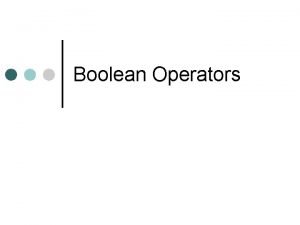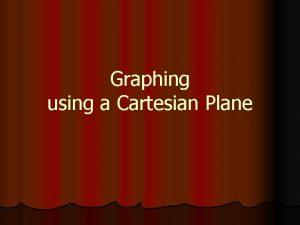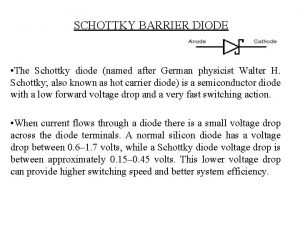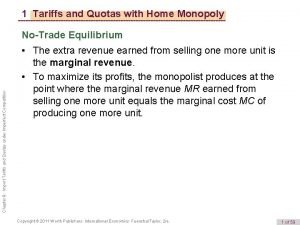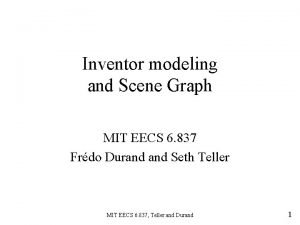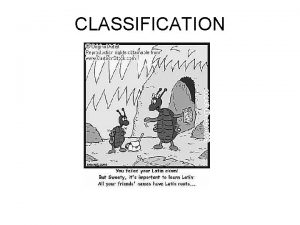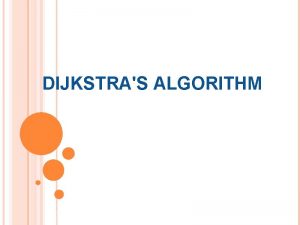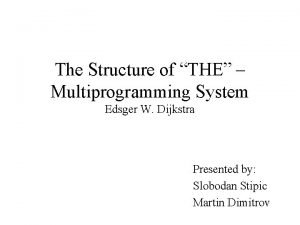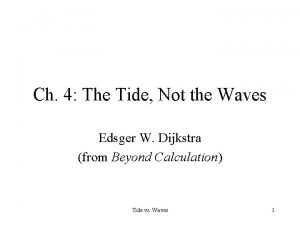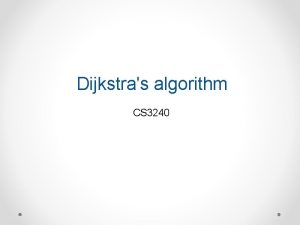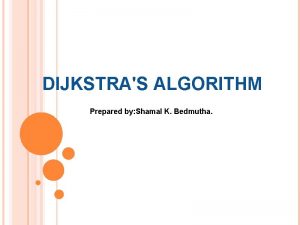Dijkstra 4 Named after its inventor Edsger Dijkstra























































- Slides: 55




Dijkstra算法 4 Named after its inventor Edsger Dijkstra (1930 -2002) Truly one of the "founders" of computer science This is just one of his many contributions




求最短路的一个例子 2 b 7 8 a 2 1 3 2 7 c s 0 4 d e 4 f 3 5 1 4 h 3 4 g 6

1, c U 1 2 b 7 8 a 8, c 2 1 s 0 4 d 4, c e 3 2 4 3 5 1 4 7, cf 7 c 2, c h 3 4 g 6

1, c S 2 b 7 1 8 a c 8, c 2 3 2 4 d 4, c 4 4 1 7, cf 3 5 U 2 e 7 0 2, c h 3 4 g 6 4, b

S 1, c 2 b 7 8 a 8, c 2 1 s 0 4 d 4, c e 3 2 4 3 5 1 4 6, e 7, cf 7 c 2, c h 3 4 g U 3 6 4, b 3, e

S 1, c 2 b 7 8 a 8, c 2 1 s 0 4 d U 4 4, c e 3 2 4 3 5 1 4 6, ef 7 c 2, c h 3 4 g 6 9, h 3, e

S 1, c 2 b 7 8 a 8, c 6, d 2 1 s 0 4 d 4, c e 3 2 4 3 5 1 4 6, ef 7 c 2, c U 5 h 3 4 g 6 9, h 3, e

1 7 8 6 2 1 2 2 7 5 3 6 2 s 0 4 4 4 3 5 4 2 1 2 2 1 3 2 6 7 s 0 4 4 3 3 4 5 4 1 5 6 9 3 3 1 6 7 9 8 6 2 1 2 2 5 2 6 7 s 0 4 4 3 5 1 3 3 3 4 9 6






Floyd-Warshall算法 动态规划方法:Use optimal substructure of shortest paths: Any subpath of a shortest path is a shortest path. 构建一个三维矩阵: � 定义dij(k):中间节点在{1, 2, 节点j的最短距离 � 最终目的是要计算dij(n) …, k}中的从节点i到




Step 1

Step 2

Step 3

Step 4

Step 5









传输网 37 The unique node with out-degree 0 The sink 4 1 4 2 5 2 3 5 4 2 3 6 3 3 Capacity of edge, Ci, j The unique node with in-degree 0 The source It is assumed that all edges are in one direction.

流(Flow) 38 (Ci, j, Fi, j), For any edge, Fi, j Ci, j 4 (4, 2) 1 (5, 3) (3, 3) 5 (4, 3) (2, 0) (2, 1) 2 (3, 2) 6 3 (3, 2) Conservation of flow: Here: 3=1+0+2 Value of the flow is 5

流(Flow) 39 Let (G, k) be a transport network with source S and sink D. Assume the capacity function k is defined on the edges of G. A flow in G is a nonnegative realvalued function F defined on the edges of G such that: � [Capacity constraint] 0 F(e) k(e) for each edge e E(G) � [Conversation equation] The value of a flow F (denoted as |F|) is defined as the value of F(S, VG) (or, F(VG, D))

例 40 The actual transported amount on any road cannot exceed the edge capacity. For any vertex, the total input amount must be equal to the output total. a (20, 20) S (60, 26) (12, 4) c (20, 13) b (16, 16) f (12, 0) (10, 10) g (20, 16) (17, 0) e (7, 7) (13, 13) (18, 16) (15, 10) h (20, 0) d (30, 20) The problem: Can we send more on the network? (30, 10) D (20, 20) i Total capacity: 70 Actual receipt: 46

最大流 41 A flow F in a network (G, k) is a maximum flow if |F| |F ’| for every flow F ’ in (G, k) (6, 4) 2 (6, 6) (2, 2) 1 (4, 4) 3 (6, 6) 4 (4, 2) Value of flow: 8 2 (6, 6) (2, 0) 1 (4, 4) 3 4 (4, 4) Value of flow: 10 Basic Problems: (1) Largest value of flow? (2) A flow with the largest value?

例 42 (6, 4) 2 (6, 6) (2, 2) 1 (4, 4) 3 4 (4, 4) Value of flow: 8 (6, 4) 1 This edge is not in N, but in N’s symmetric closure 3 3 4 (4, 4) Value of flow: 10 2 (2, 2) (6, 6) (2, 0) 1 (4, 2) 2 2 4 (4, 2)

例:容量过剩 43 : 1 2 3 4 is not a path in N, but in G, the symmetric closure. (1, 2) is in N, this edge has an excess capacity 2 (=6 -4) (6, 4) 1 This edge is not in N, but in N’s symmetric closure (2, 3) is not in N, this edge has an excess capacity 2 2 (2, 2) 3 2 4 (4, 2)

再例 44 Excess capacity: e 4, 5 4 e 4, 1 e 1, 4 1 e 4, 2 e 2, 4 5 e 4, 5 e 5, 6 e 5, 2 e 2, 5 6 e 3, 6 e 2, 1 2 Ci, j is the capacity of edge (i, j) Fi, j is the flow on edge (i, j) e 6, 5 e 2, 3 e 3, 2 ei, j=Ci, j-Fi, j ej, i=Fi, j if Fi, j>0 3 e 6, 3 edges in N edges in s(N), but not in N

45 Labeling Algorithm (Ford & Fulkson) Initialization: set all flow to 0 N 1, all nodes connected to the source by an edge with positive excess capacity Step 1: (1) Identify N 1 (2) Label nodes in N 1 as follows [4, 1] Excess capacity of (1, j) [Ej, 1] 1 Denoting node 1 4 e 1, 4= 4 e 4, 1= 0 e 1, 2= 5 e 2, 1= 0 4 2 5 2 [5, 1] 3 5 4 2 3 6 3 3

46 Labeling Algorithm (Ford & Fulkson) N 2(j), all unlabelled nodes connected to node j by an edge with positive excess capacity Also N 2, in this case Step 2: (1) Identify N 2(j), based on the node j, with the smallest number, in N 1 (2) Label nodes in N 2(j) as follows min{Ej, Excess capacity of (j, k)} [Ek, j] Denoting node j (3) Do as above for all j in N 1, and let e 4, 5= 3 e 5, 4= 0 [4, 1] 4 e 1, 4= 4 e 4, 1= 0 1 e 1, 2= 5 e 2, 1= 0 3 4 2 2 5 [5, 1] j 5 4 e 2, 5= 2 e 5, 2= 0 3 2 [2, 2] e 2, 3= 3 e 3, 2= 0 6 3 3 [3, 2]

47 Labeling Algorithm (Ford & Fulkson) Step 3: Continue as in step 2, forming N 3, N 4, N 5, . . . , until: i. the sink has been labeled, (goto step 4) ii. the sink has not been labeled, and no other nodes can be labeled according to the rules (algorithm ends, and the total flow is the maximum flow) (note: the source is not labeled) N 3, the sink has been labeled e 4, 5= 3 e 5, 4= 0 [4, 1] 4 e 1, 4= 4 e 4, 1= 0 1 e 1, 2= 5 e 2, 1= 0 3 4 2 2 5 [5, 1] j 5 e 2, 5= 2 e 5, 2= 0 3 2 [2, 2] e 2, 3= 3 e 3, 2= 0 4 [3, 3] 6 3 3 [3, 2] e 3, 6= 3 e 6, 3= 0

48 Labeling Algorithm (Ford & Fulkson) Step 4: The label of sink is [En, m] (here, [3, 3]), where En is the amount of extra flow that can be made to reach the sink through a path , and the path can be traced backward by node m Update ei, j, ej, i accordingly, and then return to step 1 [4, 1] [2, 2] 4 1 e 1, 2= 2 e 2, 1= 3 3 4 4 6 3 3 2 [5, 1] [3, 3] 2 2 5 5 j e 2, 3= 0 e 3, 2= 3 3 [3, 2] e 3, 6= 0 e 6, 3= 3

算法示例 49 4 e 1, 4= 4 e 4, 1= 0 e 1, 2= 5 e 2, 1= 0 3 5 4 4 1 e 4, 5= 3 e 5, 4= 0 e 3, 6= 4 e 6, 3= 0 2 e 2, 5= 2 2 e 5, 2= 0 5 2 3 e 2, 3= 3 e 3, 2= 0 3 6 After the first cycle 3 e 3, 6= 3 e 6, 3= 0 e 1, 4= 4 e 4, 1= 0 At the beginning, setting all flow to 0 [4, 1] 4 e 1, 2= 5 e 2, 1= 0 3 5 [2, 2] 4 4 1 e 4, 5= 3 e 5, 4= 0 2 2 e 2, 5= 2 e 5, 2= 0 5 2 [5, 1] e 3, 6= 4 e 6, 3= 0 3 e 2, 3= 3 e 3, 2= 0 3 [3, 2] 3 e 3, 6= 3 e 6, 3= 0 6 [3, 3]

算法示例 50 4 e 1, 4= 4 e 4, 1= 0 5 e 3, 6= 4 e 6, 3= 0 2 e 2, 5= 2 2 e 1, 2= 2 e 2, 1= 3 3 4 4 1 e 4, 5= 3 e 5, 4= 0 e 5, 2= 0 5 2 3 e 2, 3= 0 e 3, 2= 3 3 6 3 After the second cycle e 3, 6= 0 e 6, 3= 3 [4, 1] 4 e 1, 4= 4 After the first cycle e 4, 1= 0 e 1, 2= 2 e 2, 1= 3 3 [2, 2] 5 4 4 1 e 4, 5= 3 e 5, 4= 0 2 e 2, 5= 2 2 6 e 5, 2= 0 5 2 [2, 1] e 3, 6= 4 e 6, 3= 0 3 e 2, 3= 0 e 3, 2= 3 3 3 e 3, 6= 0 e 6, 3= 3 [2, 5]

算法示例 51 4 e 1, 4= 4 e 4, 1= 0 e 1, 2= 0 e 2, 1= 5 3 5 4 4 1 e 4, 5= 3 e 5, 4= 0 e 3, 6= 2 e 6, 3= 2 2 e 2, 5= 0 2 e 5, 2= 2 5 2 3 e 2, 3= 0 e 3, 2= 3 3 6 3 After the third cycle e 3, 6= 0 e 6, 3= 3 [4, 1] 4 e 1, 4= 4 After the second cycle e 4, 1= 0 e 1, 2= 0 e 2, 1= 5 3 [3, 4] 5 4 4 1 e 4, 5= 3 e 5, 4= 0 2 2 e 2, 5= 0 e 5, 2= 2 5 2 [2, 5] e 3, 6= 2 e 6, 3= 2 3 e 2, 3= 0 e 3, 2= 3 3 3 e 3, 6= 0 e 6, 3= 3 6 [2, 5]

算法示例 52 4 e 1, 4= 2 e 4, 1= 2 e 1, 2= 0 e 2, 1= 5 5 3 5 e 2, 5= 2 e 5, 2= 0 4 1 e 4, 5= 1 e 5, 4= 2 4 e 3, 6= 0 e 6, 3= 4 2 e 2, 5= 0 2 e 5, 2= 2 2 3 e 2, 3= 0 e 3, 2= 3 3 After the fourth cycle 6 The sink has not been labeled, so the final result reached 3 e 3, 6= 0 e 6, 3= 3 [2, 1] After the third cycle 4 e 1, 4= 2 e 4, 1= 2 4, 2 1 e 1, 2= 0 e 2, 1= 5 2, 0 5, 5 2 [1, 5] e 4, 5= 1 e 5, 4= 2 3, 2 e 2, 5= 2 e 5, 2= 0 [1, 4] 5 4, 4 2, 2 e 2, 5= 0 e 5, 2= 2 3, 3 e 2, 3= 0 e 3, 2= 3 3 e 3, 6= 0 e 6, 3= 4 6 3, 3 e 3, 6= 0 e 6, 3= 3

流与割(Flow and Cut) 53 4 Source 1 4 2 5 Cut K 1 c(K 1)=8 2 3 5 Cut: a set K of edges in a network N, having the property that every path from the source to the sink contains at least one edge from K. 4 2 3 6 3 Sink 3 Cut K 2 c(K 2)=7

Max Flow Min Cut Theorem 54 For any flow F, and any cut K, all parts of F must pass through the edges of K. Since c(K) is the maximum amount that can pass through the edges of K, so, value(F) c(K). If value(F)=c(K), then the flow uses the full capacity of all edges in K, F must be a flow with maximum value, and, on the other hand, K must be a cut with minimum capacity. Theorem A maximum flow F in a network has value equal to the capacity of a minimum cut of the network 4 (4, 2) 1 (3, 2) (2, 0) value(F)=7 5 (4, 4) 6 (2, 2) (5, 5) 2 (3, 3) 3 (3, 3)

 Edsger wybe dijkstra
Edsger wybe dijkstra Edsger dijkstra quotes
Edsger dijkstra quotes John 14:1-3
John 14:1-3 After me after me after me
After me after me after me Jamestown
Jamestown Red planet candy
Red planet candy Hera realm and symbol
Hera realm and symbol Is the victorian era named after queen victoria
Is the victorian era named after queen victoria Rogerian essay example
Rogerian essay example Neptune was named after
Neptune was named after Who was jamestown named after
Who was jamestown named after Only planet not named after a god
Only planet not named after a god Toy named after president
Toy named after president Who was athens named after
Who was athens named after Neptune is named after which god
Neptune is named after which god When will the term of office begin for a national officer
When will the term of office begin for a national officer What was harvard named after
What was harvard named after What are the juno awards named after
What are the juno awards named after The composition of venus
The composition of venus What was america named after
What was america named after Who invented boolean operators
Who invented boolean operators Cartesian plane named after
Cartesian plane named after Why schottky diode is called hot carrier diode
Why schottky diode is called hot carrier diode Paretodiagram
Paretodiagram Is back after days its tied
Is back after days its tied Is back after days its tied
Is back after days its tied If its square its a sonnet summary
If its square its a sonnet summary The emigree key themes
The emigree key themes When a train increases its velocity, its momentum
When a train increases its velocity, its momentum Its halloween its halloween the moon is full and bright
Its halloween its halloween the moon is full and bright Sunny rainy windy cloudy
Sunny rainy windy cloudy Its not easy but its worth it
Its not easy but its worth it App inventor ocr
App inventor ocr Cotton gin inventor
Cotton gin inventor App inventor location sensor not working
App inventor location sensor not working Evolution of tqm
Evolution of tqm App inventor graph
App inventor graph Navigation bar inventor
Navigation bar inventor Appinventor googlelabs com
Appinventor googlelabs com Autodesk inventor interface
Autodesk inventor interface App inventor lego mindstorm ev3
App inventor lego mindstorm ev3 App inventor vs android studio
App inventor vs android studio Cooker whistle counter app
Cooker whistle counter app Open inventor tutorial
Open inventor tutorial Horse drawn seed drill
Horse drawn seed drill Curs inventor
Curs inventor Curs inventor
Curs inventor What is an inventor
What is an inventor Melitta dresden
Melitta dresden App inventor
App inventor Propellant
Propellant Charles orren bailiff
Charles orren bailiff App inventor sensor
App inventor sensor Password app inventor
Password app inventor Orientation sensor app inventor
Orientation sensor app inventor Who was the inventor of the modern classification system
Who was the inventor of the modern classification system




















